Welcome, all people and things Gaelic
/This new newspaper is all about Gaelic culture and activity in Florida
Read MoreInternational Award-Winning Author
This new newspaper is all about Gaelic culture and activity in Florida
Read MoreThat the woman was Dutch seemed at first to be an obstacle, but then I realized it was in fact an unexpected but perfect solution.
Read MoreHow history repeats in the comparison between Thomas Cromwell and Thomas Wentworth
Read MoreRecently when I opened my Facebook account, an unexpected memory awaited. It was this picture, taken in 2001 to promote a new book that was a long time in coming, and a source of pride for these three co-authors, Terry Nosho, David G. Gordon, and yeah, that’s me in the middle.

Time has altered our faces, but not the joy and passion for that book...that book...
One day, about a year and a half before this picture was taken, a young man in jeans, mud boots and a rumpled shirt came into my office. He plopped down on our worktable a most magnificent thing: a scrapbook of enormous proportions, with a kelly-green cover nearly the size of my refrigerator door, and spiral-bound pages stacking three inches high.
“My grandfather’s an oyster grower. He’s been keeping this thing for years, sticking this and that in it,” the man said. “Newspaper articles, pictures, restaurant menus, napkins, all sorts of things. He wants to know if you can do something with it. Anyway, it’s yours now.”
Well, not mine, exactly, but the grant program for which I worked, housed with the School of Fisheries and Oceanography at the University of Washington. Our offices were repurposed student housing, a stone’s throw from Montlake cut between Lake Washington and Lake Union where the University’s famed rowing team practiced.
Our program’s educational and research support for the oyster industry, led by Terry Nosho, was well regarded as perhaps the only positive attention paid by anyone to the health and survival of oyster farming.
The whump of the scrapbook on the table was enough to draw my team from their desks: David first, being most curious; then Robyn, the graphic designer; then Susan, the webmaster. We turned the first page. I can’t speak for the rest of them but I was immediately spellbound. Those pages contained a world: not just the history of Washington state’s oyster resource, but of the farming and consumption of oysters, of their culture, and the culture of the families that made a living from them, can labels, matchbook covers, cartoons, and so much more. What could we do with such treasure?
And to me it truly was treasure, as I considered the thoughts and hands and eyes of the person who had compiled this book faithfully and consistently over the decades, the stories this book told and the stories that were never told.
On David’s thoughtful lead—he was already a published author several times over— we perused that scrapbook for different threads that we could weave into a historical look at the world of Washington oysters, complete with recipes and gorgeous photography of Washington’s iconic coast. The result was Heaven on the Half Shell, the Story of the Pacific Northwest’s Love Affair with the Oyster.
It was a powerful experience. It became an opportunity to capture its essence in an idea, grow the idea into a viable project, and then produce a book that not only encapsulates time, but also stands the test of it.
A new door had opened. The love of history and adventure ran in my veins—my favorite book as a child was Robinson Crusoe—and now I learned how to research things, what to look for, how to turn history and discovery into story, and turn story into a touchable, colorful, ink-scented book for anyone to enjoy.
It wouldn’t be long before my own history came knocking; before passion, experience and heritage merged, and I had to find out. I had to know. What happened in the lives of my ancestors? Did they actually live in...castles? Did they suffer? Did they fight? Did they rise? The truth eludes me. The facts are veiled or nonexistent. There is conjecture. Mystery. Hearsay and propaganda.
I search through the documents, books and biographies available, and fill in the blanks as I best I can. It’s a little like prying open an oyster shell, but not as sharp. And four books later I begin again, wondering still why I love it so, this thing with history?
Last month at the Amelia Island Book Festival in Florida, I received another gift: the opportunity to chat with New York Times best-selling author Margo Lee Shetterly. If you do not recognize the name, you’ll recognize her book: Hidden Figures: The American Dream and the Untold Story of the Black Women Mathematicians Who Helped Win the Space Race.
Not historical fiction, but classified as narrative non-fiction, her book required a great deal of research, and when I told her that the former journalist in me greatly admired the work she had done to create that book, we connected on the love of research.
She lamented that several of the people she’d hoped to interview for her next book had already passed away. The same was true when we were researching the oyster book. People had either passed away or were too distrusting of “government” to speak with us. I replied that, writing about the 17th century meant all my people had passed away, but fortunately in those days they wrote letters. What will happen, we wondered, when such detailed written documentation of emotion and experience is lost?
I believe we will find it still, in blog posts and videos, in personal journals, in the work of historians, archaeologists and anthropologists who will always dig for the truth.
If history infiltrates other thoughts, usurps other interests, occupies every bookshelf, makes you the geek at parties, and so on—then it is both gift and responsibility. The study of history becomes a joyful treasure hunt that not everyone seeks or understands, but the responsibility is to give attention and meaning to a particular time and people who lived it.
With the help of inspiration, you get to share these discoveries in a way that engages people so that they get those same messages. Carry on!
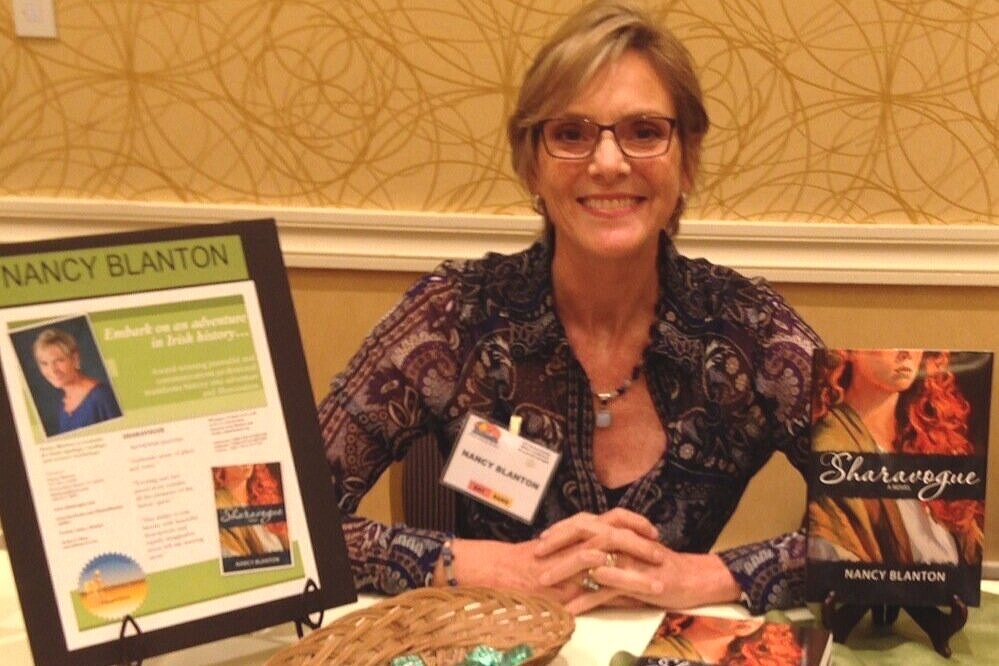
Happy after my first novel won gold at the Florida Writers Association.
Although author Nancy Blanton may not be a household name yet, after reading her intriguing novel The Earl in Black Armor we think that may very well change in the near future.
Read MoreDivided by a gentle curve in the great River Boyne, the town of Drogheda in County Louth is one of the oldest and largest in Ireland.
Read MoreMalahide Castle is famous for surviving through tumultuous and violent centuries, and provides a fascinating glimpse into life in an ancient fortress, and the enduring spirit of the family that lived there.
Read MoreIn his brightest hour, as chief advisor to King Charles I of England, he was loved by some and deeply hated by others. And yet, one is likely to feel respect for him, if not true admiration.
Read MoreAttention to detail and accuracy is what marks the difference between the hobbyist and the professional. And some of us actually enjoy the research.
Read MoreJust before the turn of the 17th century in 1593, Thomas Wentworth was born in London, into fortune, property and prestige. But he sought more than anything what he did not have: a royal title. An earldom. It would come at the greatest cost.
Read MoreThese two members of feuding Anglo-Irish families were actually cousins, and made an unlikely couple until events shifted, ultimately allowing a marriage of choice rather than arrangement.
Read MoreCharles II valued many things, including art, architecture, ships and science, but above all he had “an absolute commitment to his own survival.”
Read MoreFor personal branding, where other monarchs have provided lessons for success, King Charles I of England provides more of a cautionary tale.
Read MoreVictoria became a powerhouse in a diminutive package, similar perhaps to Napoleon Bonaparte, but she used her power in strategic ways and avoided the pitfalls that plagued the French emperor.
Read MoreThis is a beautiful and dramatic cave that has been explored extensively since it was discovered in 1833, when a Michael Condon accidently dropped his crowbar into a crevice while quarrying for stone.
Read MoreRefuge for settlers, home for fishermen, famed as of one of the worst affected by The Great Famine, Skibbereen survives and thrives in its colorful, splendid way.
Read MorePart 7 in a series featuring sites I visited in Ireland while researching my second novel, The Prince of Glencurragh. See previous post links below.
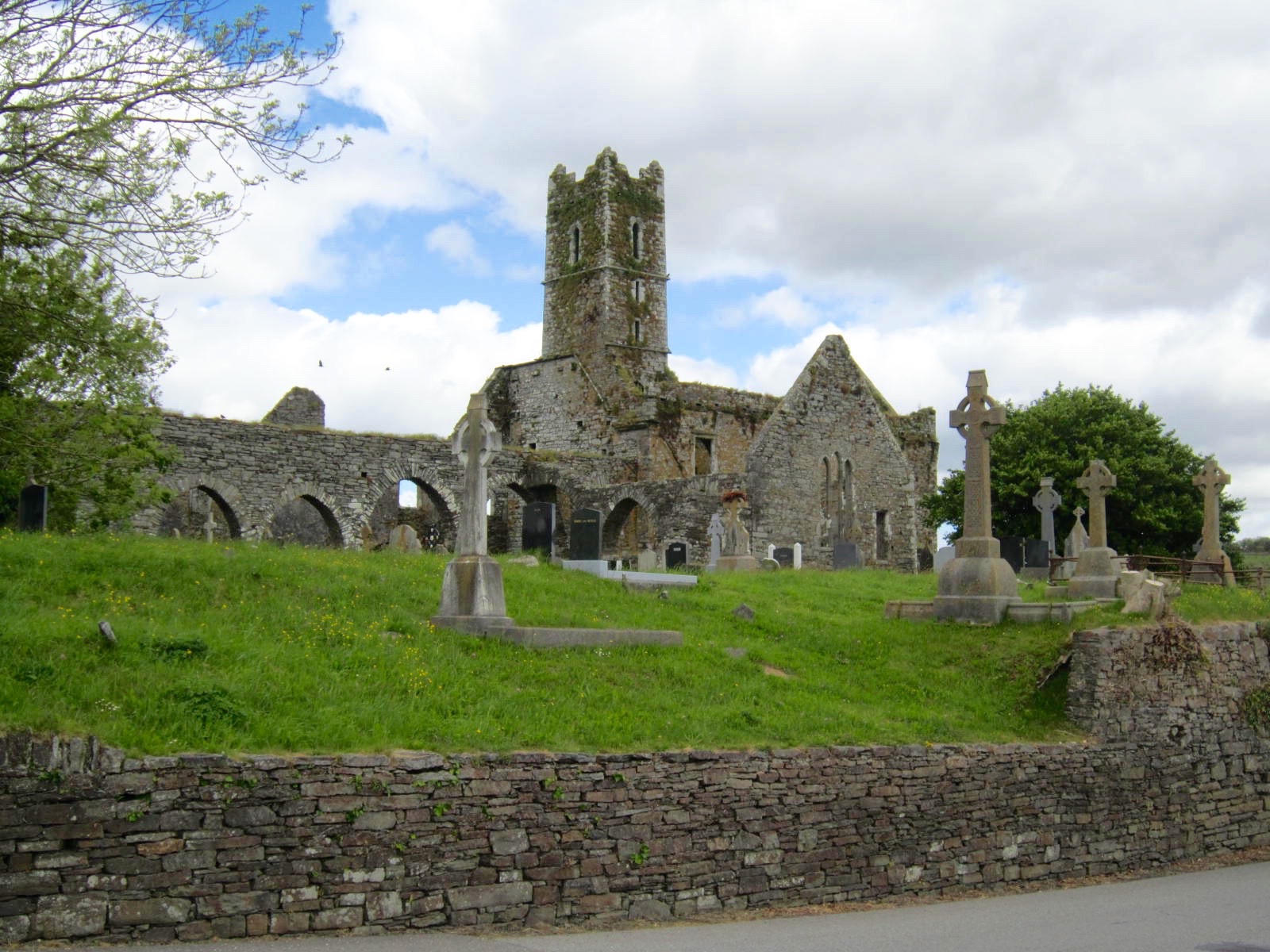 Driving south from Bandon on R602, you will arrive at the town of Timoleague in about 20 minutes, and see immediately the great landmark of Timoleague Friary. For the Prince of Glencurragh, traveling on horseback, at night and over rugged terrain, it would have taken at least three hours to reach this first stop on Faolán Burke’s path to destiny.
Driving south from Bandon on R602, you will arrive at the town of Timoleague in about 20 minutes, and see immediately the great landmark of Timoleague Friary. For the Prince of Glencurragh, traveling on horseback, at night and over rugged terrain, it would have taken at least three hours to reach this first stop on Faolán Burke’s path to destiny.
In the 17th century, local parishes were required to maintain their roads, especially in market towns. In 1634, a new act of Parliament allowed for a tax levy to cover the costs. But it would be decades before Ireland’s road systems were noted for improvements. A Scotsman traveling through Ireland in winter around 1619-1620 described his horse as “sinking to his girth” on boggy roads, his saddles and saddlebags destroyed.
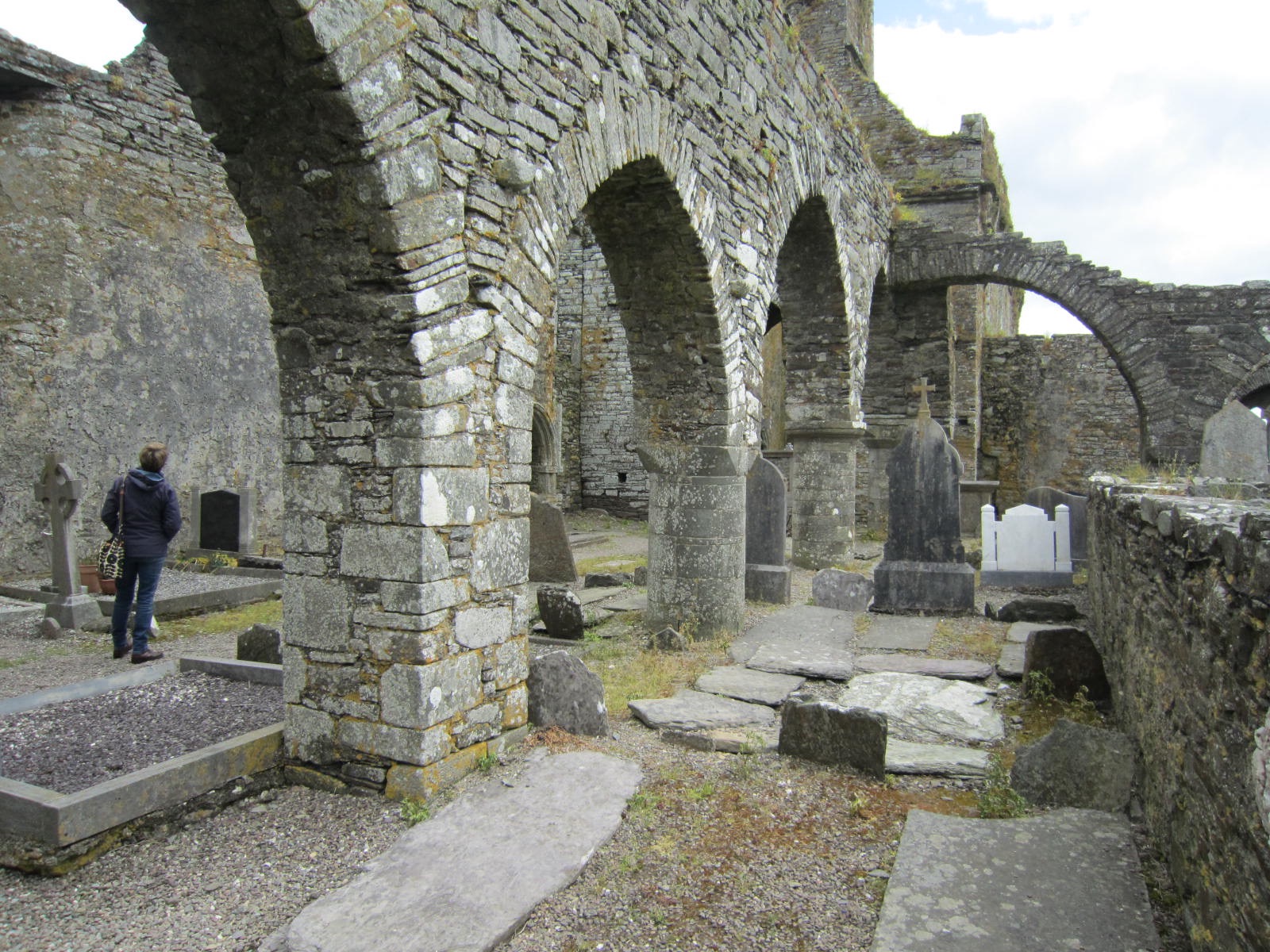 Timoleague Franciscan friary would have provided a most welcome shelter to travelers, even it its ruined state. It remains a massive and impressive structure, the walls of the various rooms still intact so that you can recognize the floor plan and how each room was used. The roof is long gone, and some sources say that parts of the structure were carted away for use in other buildings.
Timoleague Franciscan friary would have provided a most welcome shelter to travelers, even it its ruined state. It remains a massive and impressive structure, the walls of the various rooms still intact so that you can recognize the floor plan and how each room was used. The roof is long gone, and some sources say that parts of the structure were carted away for use in other buildings.
 From the mullioned window in the chorus, one would be hard-pressed to find a view more peaceful and contemplative. This is the spot where my heroine, Vivienne, considers her circumstances, having been abducted by three strange men, however benevolent they might have seemed. It’s the place where narrator Aengus recalls a treasured time with his father. And it is where he and Vivienne first realize a common bond.
From the mullioned window in the chorus, one would be hard-pressed to find a view more peaceful and contemplative. This is the spot where my heroine, Vivienne, considers her circumstances, having been abducted by three strange men, however benevolent they might have seemed. It’s the place where narrator Aengus recalls a treasured time with his father. And it is where he and Vivienne first realize a common bond.
Scenes in the book came alive for me as I entered each room and walked the same paths of monks and soldiers, and imagined conversations echoed in my mind.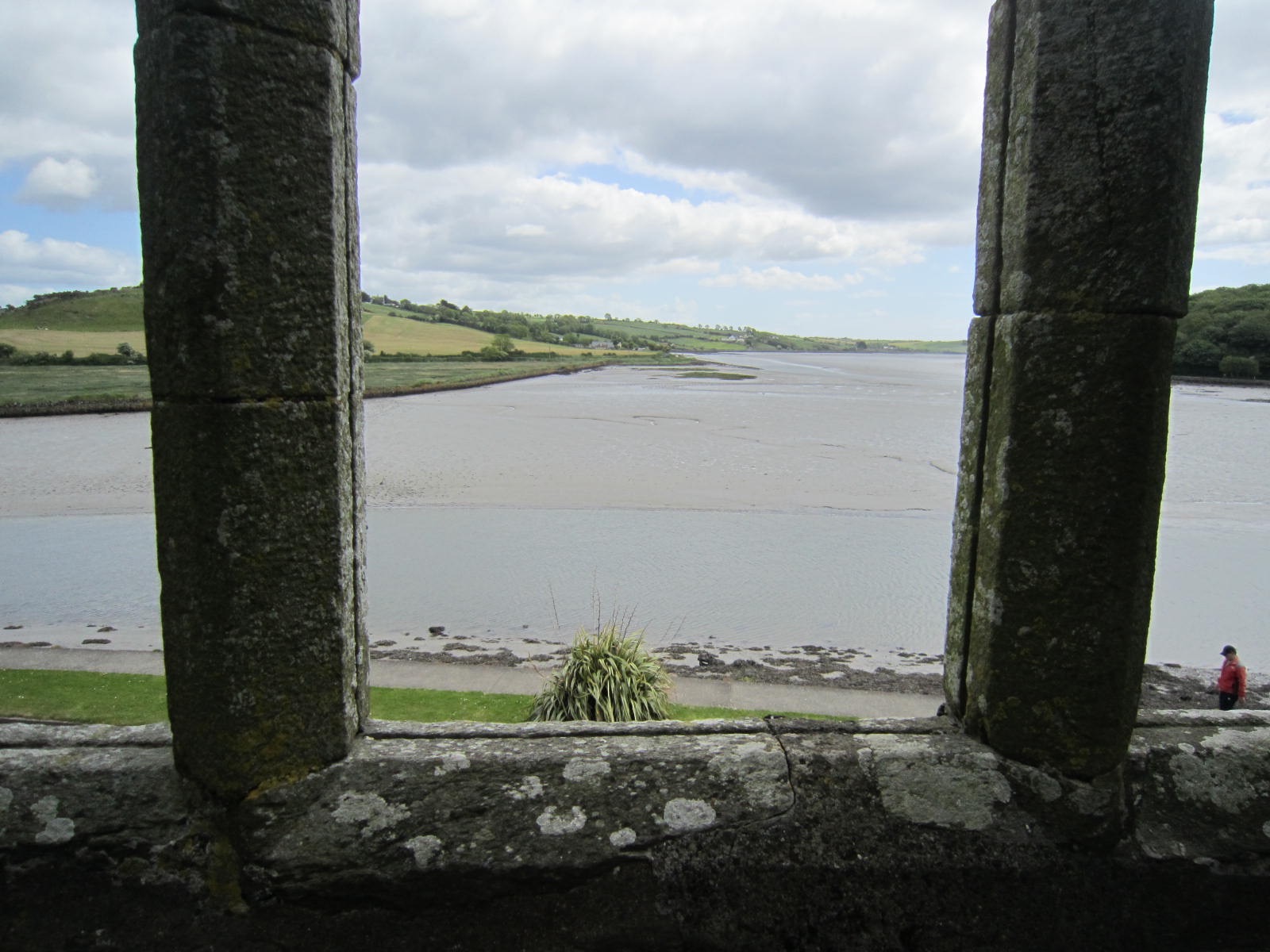
Timoleague is an Anglicization of the Irish Tigh Molaige, meaning House of Malaga for St. Malaga who is believed to have first brought beekeeping to Ireland. Foundation of the friary is attributed to the McCarthys in the 13th century, and also to William de Barry and his wife Margery de Courcy in the 14th century. Unfortunately, its position along the beautiful River Argideen and overlooking Courtmacsherry Bay made it vulnerable to Algerian pirates who sometimes cruised Ireland’s coastline in search of hostages and plunder.
 However, pirates may have seemed a minor threat compared the friary’s fate in the hands of the English. In King Henry VIII’s time, the structure was seized and as part of the Reformation the monks were dispersed. The monks returned in 1604, and then the English soldiers returned in 1612 to sack the buildings and smash all the stained glass windows. Then in 1642, English soldiers fighting the great Irish rebellion burned both the friary and town.
However, pirates may have seemed a minor threat compared the friary’s fate in the hands of the English. In King Henry VIII’s time, the structure was seized and as part of the Reformation the monks were dispersed. The monks returned in 1604, and then the English soldiers returned in 1612 to sack the buildings and smash all the stained glass windows. Then in 1642, English soldiers fighting the great Irish rebellion burned both the friary and town.
Many headstones dot the friary’s hillside, and large stone tombs in the nave are so ancient the chiseled inscriptions are no longer legible. Yet, the ruin is still an active cemetery for the local community.
Series posts:
Part 1 – Kanturk Castle Part 2 – Rock of Cashel
Part 3 – Barryscourt Part 4 – Ormonde Castle
Part 5 – Lismore Castle Part 6 - Bandon, Kilcolmen
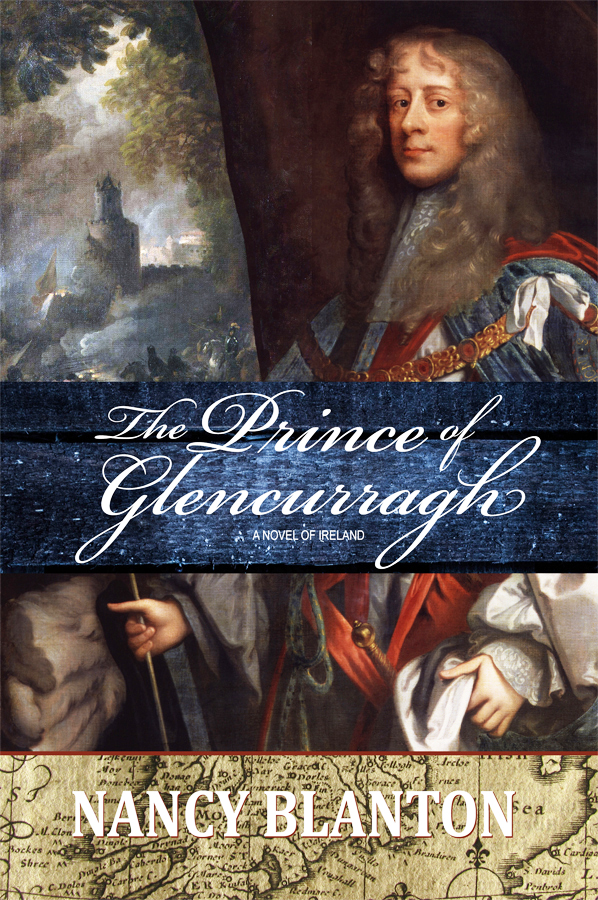 An heiress, a castle, a fortune: what could go wrong?
An heiress, a castle, a fortune: what could go wrong?
The Prince of Glencurragh is available in ebook, soft cover and hard cover from online booksellers.
https://books2read.com/u/4N1Rj6
http://www.amazon.com/Prince-Glencurragh-Novel-Ireland-ebook/dp/B01GQPYQDY/
See all of my books and other information at
Part 6 in a series featuring sites I visited in Ireland while researching my second novel, The Prince of Glencurragh. See previous posts listed at the end.
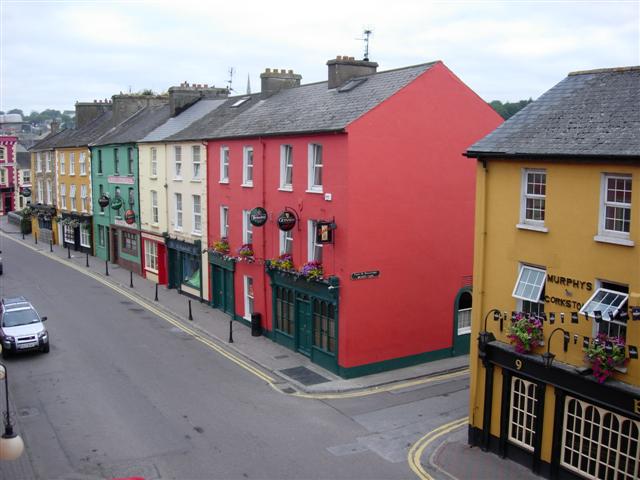
My research for The Prince of Glencurragh truly gained momentum when I visited Bandon in County Cork. Here I saw the place where my story began, and realized my reconnection with an old friend was the key that would allow the story to unfold.
Known as the gateway to West Cork, the city of Bandon lies 27 km (not quite 17 miles) west of Cork City. Established in 1604 as part of King James I’s Munster Plantation, it was a planned settlement English Protestants in Ireland. The famous stone bridge dates back at least to 1594, connecting people on either side of the Bandon River to facilitate trade. A timber bridge had existed even earlier, built by the O’Mahony (Oh-MAY-hon-ee) clan in 14th century.
When Richard Boyle, the first Earl of Cork, acquired the lease for all the properties of the town, he began a five-year project to enclose 27 acres within a wall nine feet thick and from 30 to 50 feet high in some places. On the heels of the Desmond Rebellions, this was intended to protect the peaceful settlers within against the wild Irish without.
Protection was needed against the unrest the settlement itself had created. Bandon lands had belonged to the O’Mahony and McCarthy clans, and the displacement left Irish families homeless and their sons without inheritance, sowing seeds for an even greater rebellion than the Desmonds could muster.
For the story in The Prince of Glencurragh, Bandon’s wall is critical, because certain local laws were enforced by a sheriff within the town’s walls, but did not extend beyond them. When the would-be “prince” Faolán Burke abducts his heiress from a rectory situated outside the town walls, technically he has broken no laws.
In preparation for my travels, my research uncovered a near-perfect model for this rectory, the Kilcolmen Rectory just east of where the walls of Bandon would have reached. To my surprise and delight, my dear friends and guides Eddie and Teresa actually live in Bandon (I had thought they still lived in Templemore).
I met Eddie when I was 19 or 20, visiting Ireland for a summer study program, and had the privilege of staying with his family in Skibbereen for a few days. We had not seen each other in decades, and so the reconnecting was gratifying and emotional.
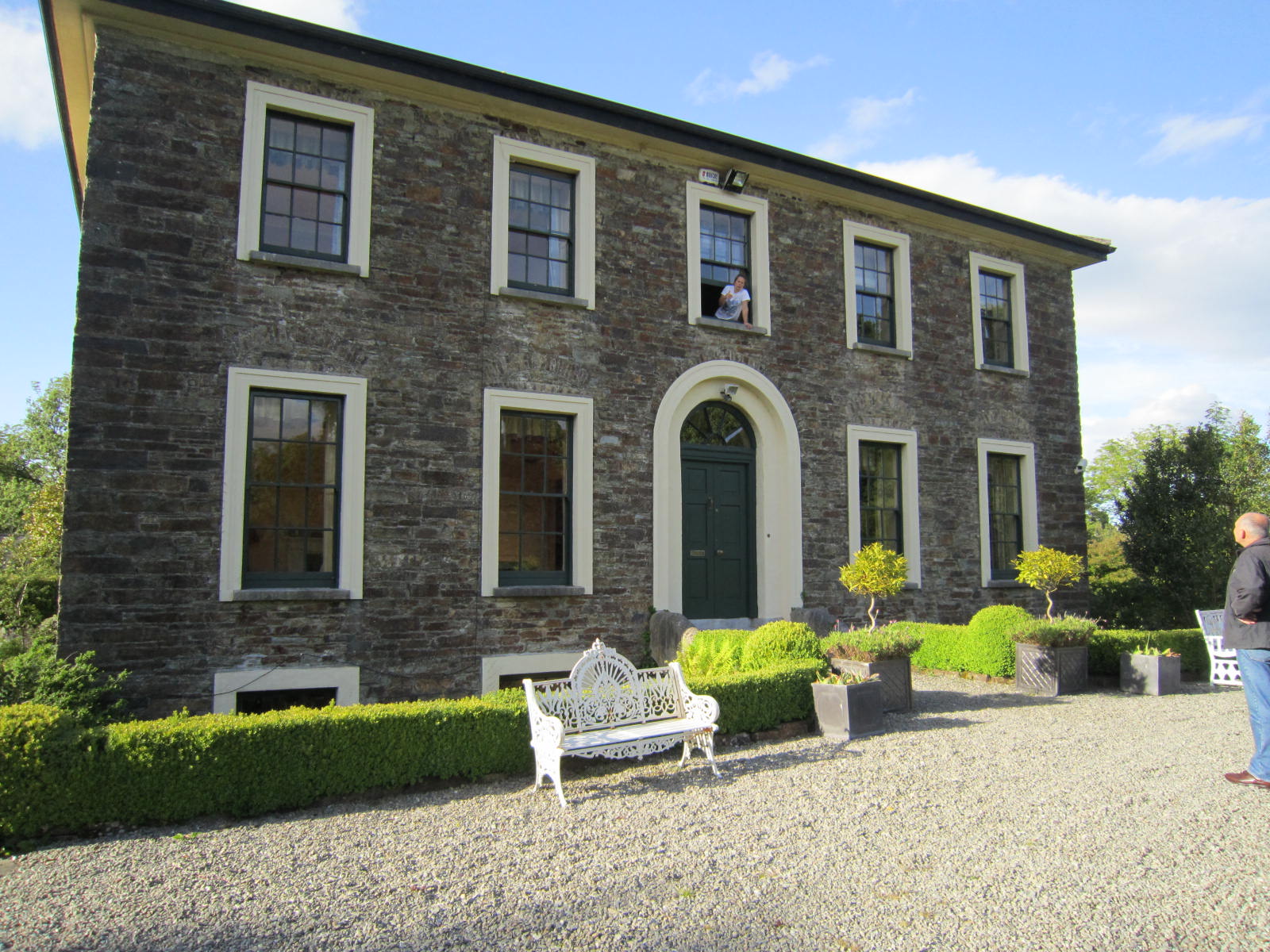 Eddie knew of the rectory and was able to take me straight there. Though it is now a private home, Eddie chatted with the resident—she was leaning out of the upstairs bathroom window where she’d been bathing her children—while I looked about the house and grounds. We did not go inside, but Eddie sent me some interior photos he happened upon when the house went on the real estate market months later.
Eddie knew of the rectory and was able to take me straight there. Though it is now a private home, Eddie chatted with the resident—she was leaning out of the upstairs bathroom window where she’d been bathing her children—while I looked about the house and grounds. We did not go inside, but Eddie sent me some interior photos he happened upon when the house went on the real estate market months later.
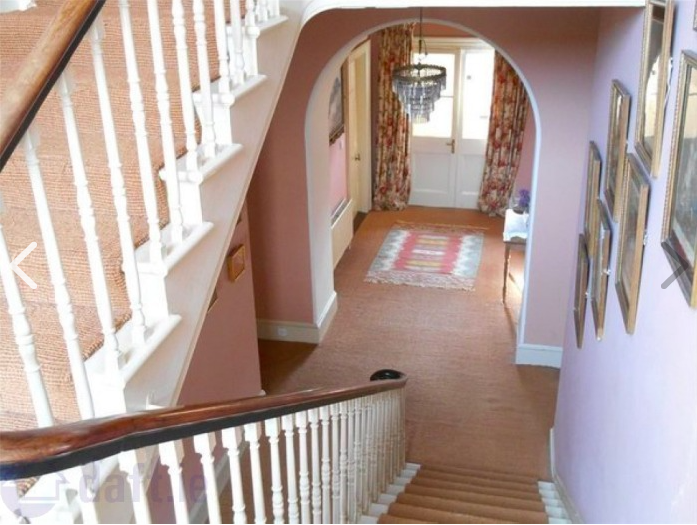 This rectory is much larger and finer than the one I had imagined, but served quite well to give me an authentic feel for the place. The front door is opposite the stairs, and on either side are doorways to the parlor and the dining room. I loved the enormous windows of the place, and the high ceilings. The bedroom is where the character Vivienne would have pushed her bed beneath a window to wait for St. Agnes to reveal the image of the man she would marry. The road outside would have been a dirt carriage path instead of a nice, clean paved drive.
This rectory is much larger and finer than the one I had imagined, but served quite well to give me an authentic feel for the place. The front door is opposite the stairs, and on either side are doorways to the parlor and the dining room. I loved the enormous windows of the place, and the high ceilings. The bedroom is where the character Vivienne would have pushed her bed beneath a window to wait for St. Agnes to reveal the image of the man she would marry. The road outside would have been a dirt carriage path instead of a nice, clean paved drive.
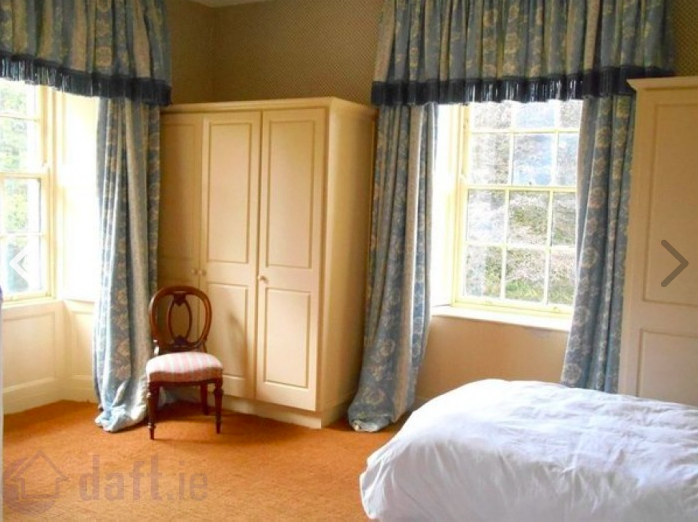 Eddie later showed me that Bandon’s town walls are mostly invisible now but for some crumbling remnants. Still, the wall sets the town apart and Bandon is a member of the Irish Walled Towns Network.
Eddie later showed me that Bandon’s town walls are mostly invisible now but for some crumbling remnants. Still, the wall sets the town apart and Bandon is a member of the Irish Walled Towns Network.
Upon seeing these things, the story became real to me and I could tell it with sincerity. But the truth is I would never have found or seen the places I was looking for without Eddie and Teresa. It is one thing to look at a map and draw circles and lines, and yet another to actually find your way around a mostly unmarked and unfamiliar region. They took me everywhere I wanted to go, for they knew each place already, and even more than that, they had personal history with some of them, a love of exploration, and an often unspoken but clear reverence for the land and its history.
They showed me a ruin not on my list, but beautiful and fascinating: Castle Bernard. Where once there had been a medieval castle belonging to the O’Mahonys, in 1788 the first earl of Bandon, Francis Bernard, built a beautiful mansion with tall windows and soaring castellated towers.
By the time it was inhabited by the 4th earl, James Francis Bernard, a new and modern rising came from the IRA. In June 1921, while the earl hid in the cellar, IRA soldiers set fire to the castle and captured the earl as he tried to escape. Now mostly swallowed up by the woods and vines, the magnificence and inaccessibility of the ruin spur the imagination.
From Bandon we would travel for three spectacular days to uncover the rest of Faolán Burke’s trail.
As a side note, my friends in the Pacific Northwest might like to know that Bandon has a twin city agreement with Bandon, Oregon. In 1873, Lord George Bennet founded the city and named it after his hometown in Ireland. Bennet is known for introducing the lovely-flowering but highly troublesome gorse to the American landscape.
Thanks to: Irish Walled Town Network, Heritage Bridges of County Cork (Cork County Council), Castles.nl, Wikipedia and other sources.
Part 1 - Kanturk Castle
Part 2 - Rock of Cashel
Part 3 - Barryscourt
Part 4 - Ormonde Castle
Part 5 - Lismore Castle
 An heiress, a castle, a fortune: what could go wrong?
An heiress, a castle, a fortune: what could go wrong?The Prince of Glencurragh is available in ebook, soft cover and hard cover from online booksellers.
https://books2read.com/u/4N1Rj6
http://www.amazon.com/Prince-Glencurragh-Novel-Ireland-ebook/dp/B01GQPYQDY/
Part 5 in a series featuring sites I visited in Ireland while researching my second novel, The Prince of Glencurragh. See previous post links below.
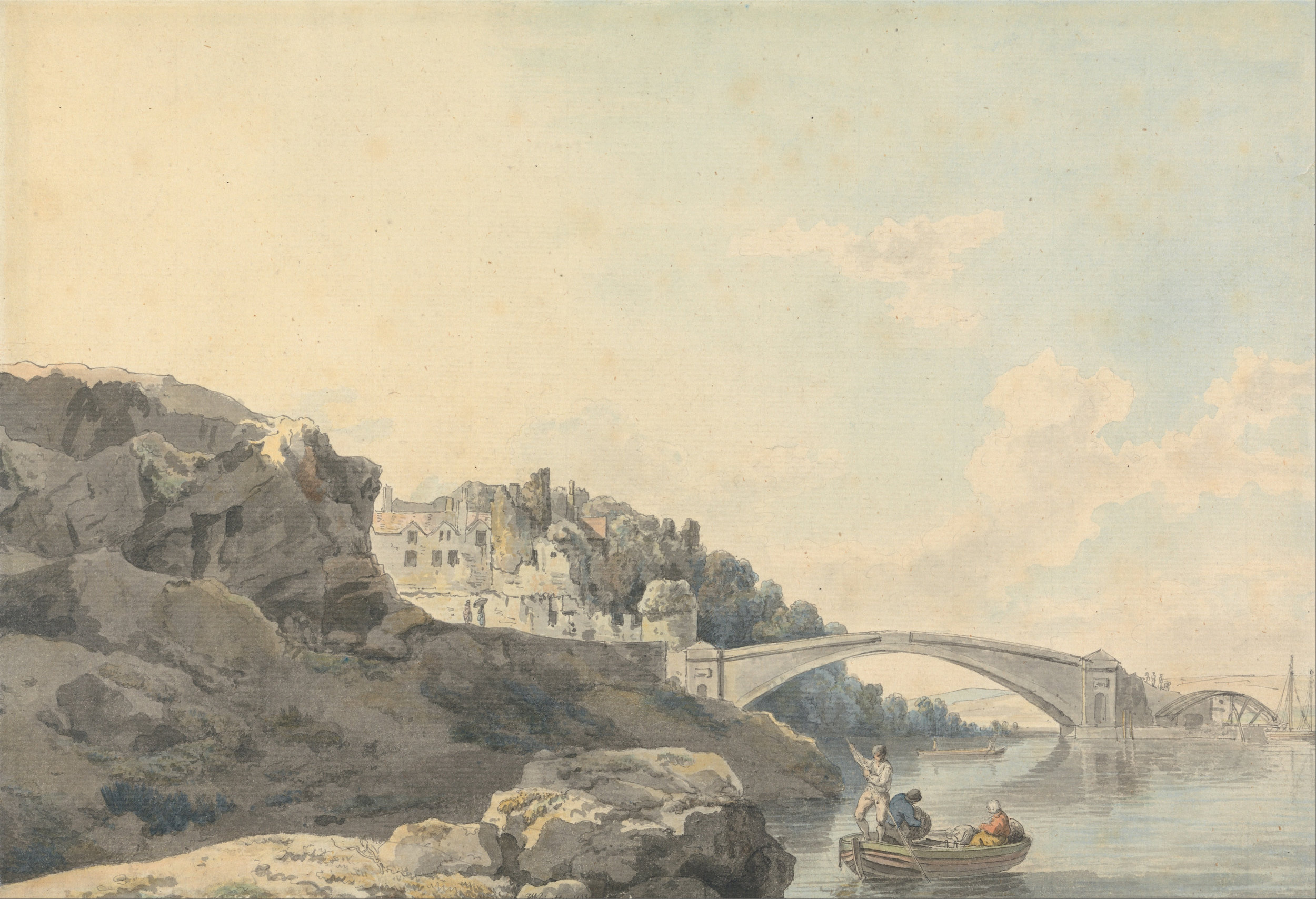
In The Prince of Glencurragh, the spectacular Lismore Castle in County Waterford is the setting for three emotionally-charged scenes. The grand drawing room and the ancient towers provide dramatic backdrops that help fortify the story.
Taking its name from “lis” meaning fort and “mor” meaning great, the castle is situated on the right bank of the River Blackwater in County Waterford. One story has it that when King James II visited the castle, he backed away from the grand window overlooking the river, startled by the sheer drop to the riverbank when the entrance to the castle is on 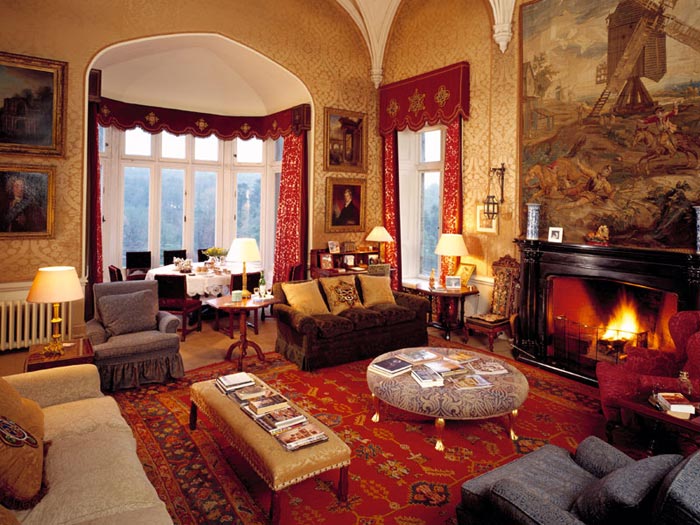 ground level. The window was ever-after called King James’s window.
ground level. The window was ever-after called King James’s window.
Sources differ as to the date of construction, but sometime between 1179 and 1185, Lismore was built on the site of the ancient abbey of Mochuda.
“This fine castle was originally founded by the Earl of Moreton, afterwards King John, in the year 1185, and is said to have been the last of three fortresses of the kind which he erected during his visit to Ireland. In four years afterwards it was taken by surprise and broken down by the Irish, who regarded with jealousy and fear the strong holds erected by the English to secure and enlarge their conquests.” -- LibraryIreland.com, the Dublin Penny Journal, Volume 1, Number 43, April 20, 1833
The castle was later rebuilt as an Episcopal residence (one source says it belonged to the earls of Desmond), until in 1589 when the manor and lands were granted to Sir Walter Raleigh. Sir Walter fell from grace after the death of Queen Elizabeth, and sold the estate to Sir Richard Boyle, the first Earl of Cork. Raleigh was later executed by King James to appease the Spanish, who saw Raleigh as a plundering pirate.

Lord Cork made extensive improvements to the castle for use as his primary residence. Outbuildings were added, and interiors embellished with fretwork plaster ceilings, tapestry hangings, embroidered silks and velvet.
“The first door-way is called the riding-house, from its being originally built to accommodate two horsemen, who mounted guard, and for whose reception there were two spaces which are still visible under the archway. The riding-house is the entrance into a long avenue shaded by magnificent trees, and flanked with high stone walls; this leads to another doorway, the keep or grand entrance into the square of the castle. Over the gate are the arms of the first Earl of Cork, with the motto, "God's providence is our inheritance.” -- LibraryIreland.com, the Dublin Penny Journal
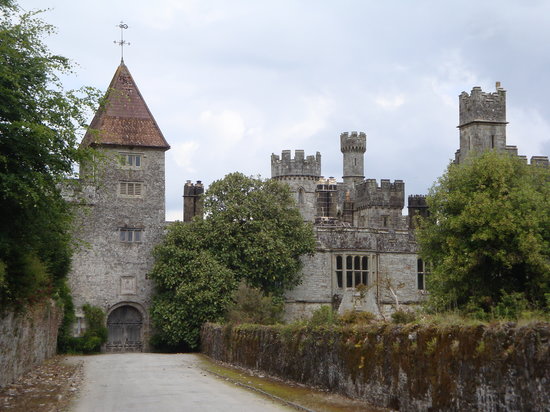 Some of the outbuildings were destroyed in the rebellion of 1641 when the castle was closely besieged by 5,000 Irish, and defended by Lord Broghill, the earl’s third son.
Some of the outbuildings were destroyed in the rebellion of 1641 when the castle was closely besieged by 5,000 Irish, and defended by Lord Broghill, the earl’s third son.
The Cavendish family acquired the castle in 1753 when the daughter and heiress of the 4th Earl of Cork, Lady Charlotte Boyle, married William Cavendish, 4th Duke of Devonshire, who became Prime Minister of Great Britain & Ireland. The 9th Duke, Lord Charles Cavendish, married Adele Astaire, the sister and former dancing partner of Fred Astaire.
Lismore is now an exclusive accommodation and event venue, and even offers culinary packages. The famous gardens are open to the pubic. The upper garden is a 17th-century walled garden, also briefly featured in my book.
Read other posts in the series: Part 1, Part 2, Part 3, Part 4.
 An heiress, a castle, a fortune: what could go wrong?
An heiress, a castle, a fortune: what could go wrong?
The Prince of Glencurragh has won the Royal Palm Literary Award for historical fiction. It is a story of 17th century Ireland, in a time of sweeping change prior to the great rebellion of 1641. Available in ebook, soft cover and hard cover from online booksellers.
https://books2read.com/u/4N1Rj6
http://www.amazon.com/Prince-Glencurragh-Novel-Ireland-ebook/dp/B01GQPYQDY/
See all of my books and sign up for my newsletter (published only 3 or 4 times a year) at nancyblanton.com
Part 4 in a series featuring sites I visited in Ireland while researching my second novel, The Prince of Glencurragh. See Part 1, Part 2 and Part 3.
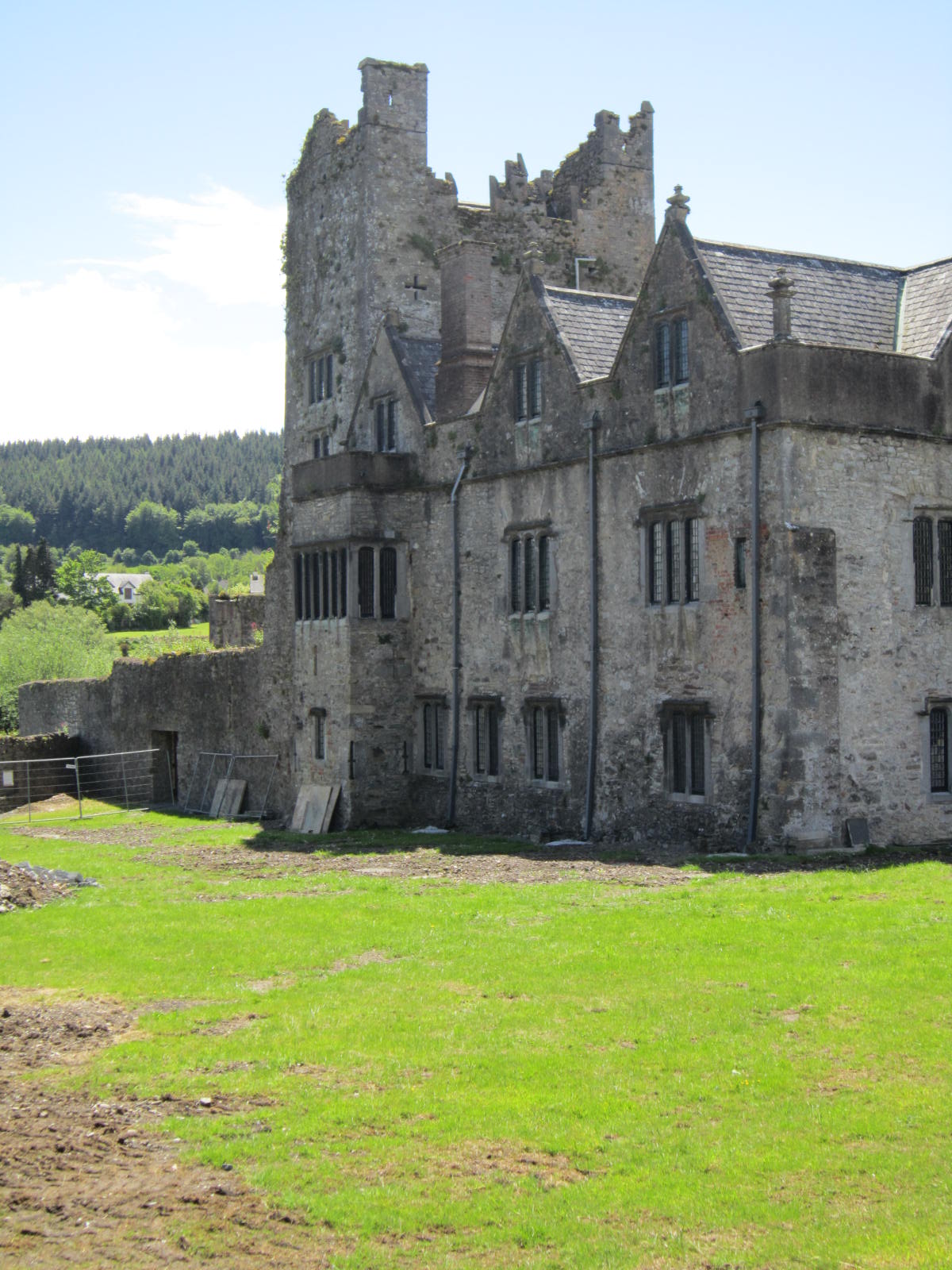 It is always thrilling to be in Ireland, although during my research trip there were some disappointments. The greatest of these was finding Carrick on Suir, (now known as Ormonde Castle to distinguish it from the town), closed for renovations for the entire year. My advance research somehow did not disclose this, so upon arrival, all I could do was walk around all sides, take pictures, and use my imagination.
It is always thrilling to be in Ireland, although during my research trip there were some disappointments. The greatest of these was finding Carrick on Suir, (now known as Ormonde Castle to distinguish it from the town), closed for renovations for the entire year. My advance research somehow did not disclose this, so upon arrival, all I could do was walk around all sides, take pictures, and use my imagination.
[As of this writing, the castle remains closed to visitors due to renovations, but is scheduled to reopen in June, 2017.]
Situated along the River Suir on the east side of the village in County Tipperary, this castle exudes history. It is remarkable for being Ireland’s only unfortified manor house from the Tudor period, and for the quality of plasterworks within. On the river side you see a classic 14th century castle with two towers, east and west, but then it is knitted together on the upland side with a majestic Tudor mansion. (See a tour video here.)
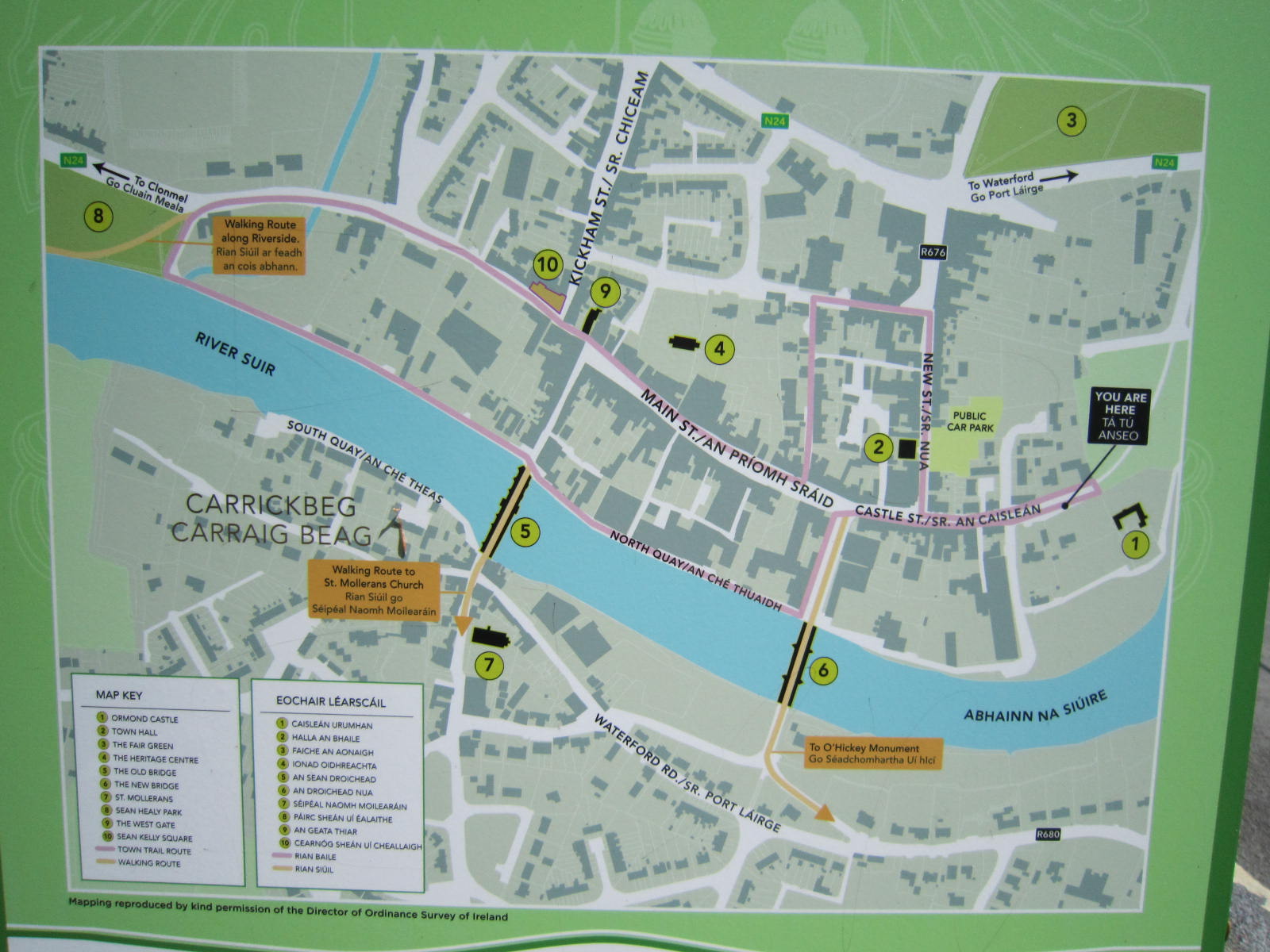
Carrick means bend or knot, and may have originally referred to the location along a bend in the river, but there is also a famous “carrick knot,” a rope knot having open-ended loops, symbolizing the nautical knot used by boatmen who worked along the river.
The most charming feature of this castle is the mullioned Tudor windows with their many small panes known as “quarries.” There are so many of these beautiful windows, and at one point I could see light all the way through to the opposite side of the house. It’s a rare thing to see a castle that so embraces the daylight. (For more about the history of windows in Ireland, see this wonderful site.)
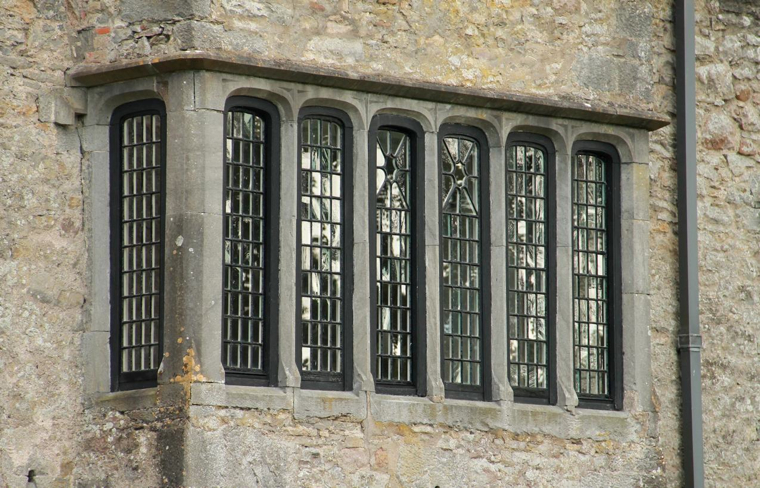
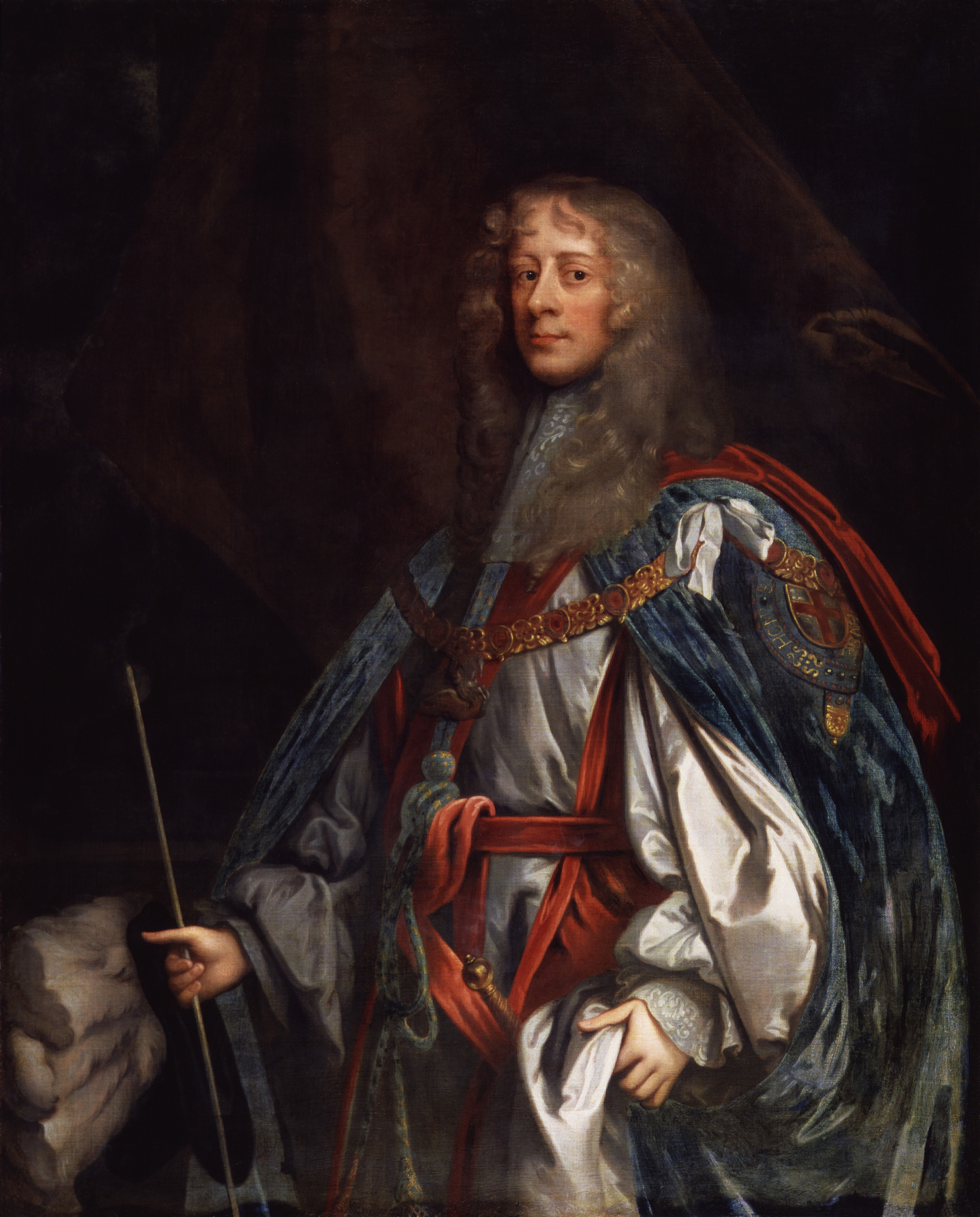
Built by Thomas Butler, the 10th Earl of Ormonde (and Queen Elizabeth’s cousin), in the 1560s, the manor house became the preferred residence of James Butler, 12th Earl of Ormonde, later the first Duke of Ormonde, during the 17th century. This is truly saying something, for the Butlers were the second-largest landholders in Ireland and their properties included more than 30 manors and houses. Among their holdings was the famous Kilkenny castle, the seat of power for the Butler family.
The story goes that, shortly before Thomas died, four-year-old James was playing behind the earl's chair. The old man held the child between his knees and prophesied, "My family shall be much oppressed and brought very low; but by this boy it shall be restored again, and in his time be in greater splendor than ever it has been." Later events proved the earl's prophesy to be true, for when James ascended to the earldom he became known as a valiant and honest man, was highly respected by all sides and, among other things he founded the woolen industry. James led the Irish confederates against Oliver Cromwell's Parliamentary forces in the mid-17th century, and subsequently lost much of the family's property and wealth, but it was restored during the restoration of King Charles II, and James was created Duke of Ormonde for his loyalty and service to the crown.
Ormond Castle interiors were known for their magnificent plasterwork, and for grand tapestries adorning the walls of the great hall. In my book, The Prince of Glencurragh, a scene takes place in Ormonde Castle, where the Earl, James Butler, receives young messenger Aengus O’Daly who is awestruck by the beauty of the hall and these tapestries, and humbled by the many representations of royalty and power. (I saved a couple of interior images to my Pinterest page on Ireland, but can't post them here. Follow me there for these and other images.)
 An heiress, a castle, a fortune: what could go wrong?
An heiress, a castle, a fortune: what could go wrong?
The Prince of Glencurragh is available in ebook, soft cover and hard cover from online booksellers.
https://books2read.com/u/4N1Rj6
http://www.amazon.com/Prince-Glencurragh-Novel-Ireland-ebook/dp/B01GQPYQDY/
See all of my books and other information at nancyblanton.com
Nancy Blanton is the award-winning author of Sharavogue, a historical novel set in 17th Century Ireland during the time of Oliver Cromwell, and in the West Indies, island of Montserrat, on Irish-owned sugar plantations. She has two more historical novels underway, as well as a non-fiction book about personal branding, Brand Yourself Royally in 8 Simple Steps. She also wrote and illustrated a children's book, The Curious Adventure of Roodle Jones, and co-authored Heaven on the Half Shell, the Story of the Pacific Northwest's Love Affair with the Oyster.